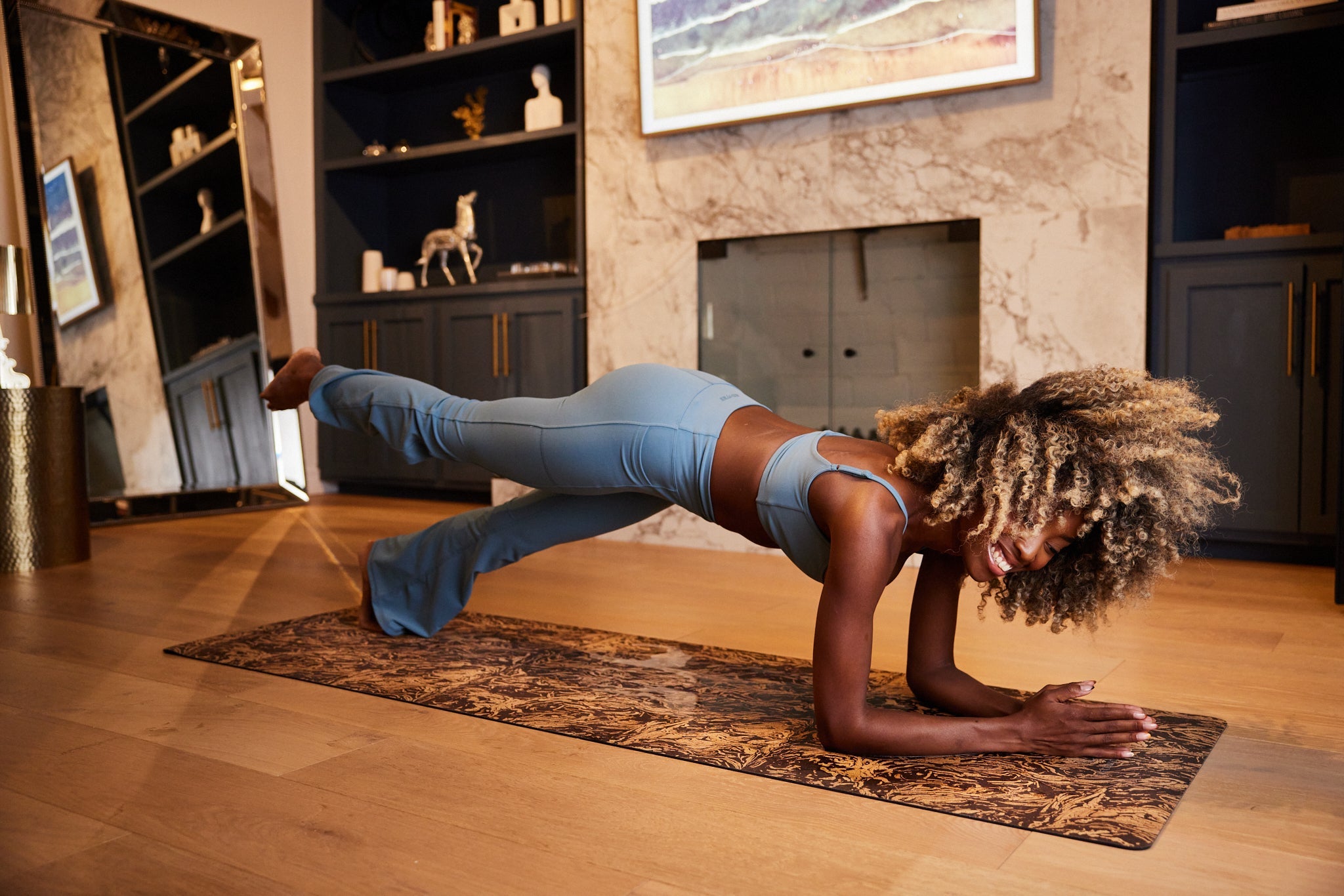Introduction
Yoga enthusiasts are always on the lookout for the perfect mat to enhance their practice. Cork yoga mats have gained popularity as a sustainable and eco-friendly option, offering excellent grip and stability. However, even these natural wonders can sometimes slip, causing frustration and potential safety concerns during intense sessions or when dealing with sweaty palms.
Understanding how to prevent a cork yoga mat from slipping is crucial to maintain a seamless flow and focus during practice. This article explores the key factors that affect mat grip, including choosing the right cork mat, proper maintenance techniques, and environmental considerations. By implementing these strategies, practitioners can ensure their cork yoga mat remains a reliable, non-slip surface for a stable and enjoyable yoga experience.
Choosing the Right Cork Yoga Mat
Thickness Considerations
When selecting a cork yoga mat, thickness plays a crucial role in comfort and performance. The ideal thickness ranges from 3mm to 4.5mm, striking a balance between cushioning and stability ([1]). Thinner mats (2-3mm) are lightweight and suitable for travel but offer less joint protection ([2]). Thicker mats (6mm) provide extra cushioning for sensitive joints but may compromise balance ([2]). For most practitioners, a 4-5mm mat offers optimal support and grounding ([1]).
Quality Indicators
High-quality cork yoga mats are durable and resistant to wear and tear ([3]). They often feature a combination of cork and natural rubber or TPE foam for superior cushioning ([4]). Cork mats are naturally antimicrobial, resisting germs and odors, which is beneficial for sweaty practices and storage ([4]). Additionally, cork does not absorb dust, making it a good option for those with allergies or skin sensitivities ([4]).
Sustainable Options
Cork yoga mats are an eco-friendly choice for environmentally conscious yogis. Cork is a sustainable material harvested from the bark of cork oak trees without harming them ([3]). Many brands seek certifications from organizations like OEKO-TEX and Fair Rubber Association to ensure sustainable sourcing ([4]). Cork is also biodegradable, reducing environmental impact ([3]). When choosing a sustainable cork yoga mat, look for brands that prioritize eco-friendly practices and materials ([5]).
Maintaining Your Cork Mat for Optimal Grip
Regular Cleaning Routine
Cork yoga mats are naturally antimicrobial, containing compounds called Phenolics that kill bacteria and fungus ([6]). This self-cleaning property helps keep the mat free from odors caused by perspiration and body sweat. Despite this, regular maintenance is still important to ensure optimal grip and longevity.
It's recommended to clean the mat after every use, especially after sweaty sessions ([7]). A quick wipe-down with a soft, damp cloth can be sufficient for daily maintenance ([8]). For a more thorough cleaning, aim to clean the mat once a week, or more frequently if used daily or for intense practices ([8]).
Natural Cleaning Solutions
To clean a cork yoga mat, it's best to use natural, gentle solutions:
-
Water and vinegar: Mix equal parts water and vinegar in a spray bottle ([9]).
-
Water and witch hazel: Combine one part witch hazel with one part water ([9]).
-
Essential oil mixture: Add 3-4 drops of essential oil (such as lavender, tea tree, lemongrass, or eucalyptus) to water in a spray bottle ([8]).
Avoid using harsh chemicals or expensive cleaners, as they can damage the cork ([7]). For stubborn marks, a mixture of water, vinegar, and baking soda can be effective ([6]).
Drying and Care
After cleaning, it's crucial to dry the mat properly:
-
Leave the mat laid out flat to dry completely ([7]).
-
If needed for transport, unroll the mat at home to allow full drying ([7]).
-
Hang the mat to air dry if it's taking longer to dry ([9]).
Ensure the mat is completely dry before storing to prevent mold or mildew growth ([9]). When storing, roll the mat with the cork side facing outwards to maintain its shape and ensure it lays flat during use ([8]). Avoid folding the mat, as this can damage the cork surface ([9]).
Environmental Factors Affecting Mat Grip
Room Temperature
The temperature of the practice space significantly influences the performance of cork yoga mats. In hot yoga environments, cork mats excel by maintaining their grip even as perspiration increases ([10]). The unique cellular structure of cork, composed of tiny air pockets, allows for rapid absorption and release of moisture, ensuring stability during dynamic sequences ([10]). This feature is particularly beneficial in heated conditions where traditional rubber mats might become slippery.
Humidity Levels
Humidity plays a crucial role in the grip of cork yoga mats. Interestingly, cork mats become more grippy when exposed to moisture ([11]). As practitioners sweat, the cork releases a waxy substance called Suberin, which enhances the non-slip properties of the mat ([12]). This makes cork yoga mats an excellent choice for various practices, including hot yoga, where humidity levels are typically higher ([12]).
Floor Surface Types
The type of floor surface can impact the overall stability of a cork yoga mat. Cork mats are versatile and suitable for both indoor and outdoor practices ([11]). However, it's important to clean the mat after outdoor use to remove any dirt or dust that might affect its grip ([11]). The natural rubber backing often found in cork mats contributes to their stability on different surfaces, minimizing movement during practice ([11]).
Conclusion
Mastering the art of preventing a cork yoga mat from slipping has a significant impact on the overall yoga experience. By choosing the right mat thickness, maintaining proper cleaning routines, and understanding how environmental factors affect grip, practitioners can enjoy stable and safe practice. These insights allow yogis to make the most of their cork mats' natural properties, enhancing their focus and flow during each session.
To wrap up, cork yoga mats offer a sustainable and effective solution for those seeking stability in their practice. Their unique characteristics, such as improved grip with moisture and natural antimicrobial properties, make them a top choice for various yoga styles. To experience these benefits firsthand, use the promo code "BestCorkYogaMat" to get 15% off your next cork yoga mat purchase. By implementing the strategies discussed, yogis can ensure their cork mat remains a reliable companion on their journey to wellness and inner peace.
FAQs
Q: How can I make my cork yoga mat less slippery?
A: To reduce slipperiness on a cork yoga mat, lightly spray it with water before starting your session. The moisture enhances the grip due to the natural waxy substance in cork called Suberin.
A: To reduce slipperiness on a cork yoga mat, lightly spray it with water before starting your session. The moisture enhances the grip due to the natural waxy substance in cork called Suberin.
Q: What are some tips to prevent my yoga mat from slipping during practice?
A: To keep your yoga mat from slipping, practice proper technique and keep your core engaged. Regular use of your mat also increases its grip over time. Clean your mat with suitable products, avoid lotions or oils before yoga, and consider using a yoga towel for extra stability.
A: To keep your yoga mat from slipping, practice proper technique and keep your core engaged. Regular use of your mat also increases its grip over time. Clean your mat with suitable products, avoid lotions or oils before yoga, and consider using a yoga towel for extra stability.
Q: Do cork yoga mats offer a non-slip surface?
A: Yes, cork yoga mats are known for their naturally grippy texture, which provides excellent traction. This helps in preventing slips and slides, allowing for better alignment and stability during various poses.
A: Yes, cork yoga mats are known for their naturally grippy texture, which provides excellent traction. This helps in preventing slips and slides, allowing for better alignment and stability during various poses.
Q: What is the best way to maintain a cork yoga mat?
A: Maintain your cork yoga mat by gently wiping it with a soft cloth dampened with cold water. Allow the mat to air dry completely before rolling it up for storage. Avoid using abrasive sponges as they can damage the mat.
A: Maintain your cork yoga mat by gently wiping it with a soft cloth dampened with cold water. Allow the mat to air dry completely before rolling it up for storage. Avoid using abrasive sponges as they can damage the mat.
References
[1] - https://www.diyogi.com/blogs/diyogi-yoga-mat-articles-info/the-best-yoga-mat-thickness [2] - https://www.scoriaworld.com/blogs/blog/mat-thickness-length-differences [3] - https://yuneyoga.com/blogs/yoga-blog/choosing-the-right-cork-yoga-mat-for-your-practice [4] - https://reviewed.usatoday.com/health/features/cork-yoga-mat-review-gaiam [5] - https://www.zonebylydia.com/blogs/inthezone/choosing-the-right-yoga-mat [6] - https://www.corkyogis.com/blog/how-to-clean-yoga-mat [7] - https://yolohayoga.com/blogs/yoloha-life/how-to-care-for-your-cork-yoga-mat [8] - https://www.everydayyoga.com/blogs/official/the-best-way-to-clean-care-for-a-cork-yoga-mat [9] - https://bodybyyoga.training/yoga-mats/how-to-clean-a-cork-yoga-mat/ [10] - https://bohoflow.co/cork-yoga-mats-for-hot-yoga/ [11] - https://asivanayoga.com/blogs/yoga-blog/flux-cork-yoga-mat-care [12] - https://www.thesatoriconcept.com/blogs/yogatips/are-cork-yoga-mats-slippery




Leave a comment
This site is protected by hCaptcha and the hCaptcha Privacy Policy and Terms of Service apply.